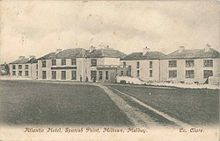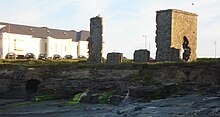The Atlantic Hotel was a hotel in Spanish Point, County Clare, Ireland. It was built around 1810 by Thomas Moroney, a member of the family of local landlords. For several years it was described as the "largest hotel in the British Isles".[1] The hotel closed in the 1930s and, with the exception of one section which continued to operate for a period as a licensed premises, was demolished in the 1940s.[2] A new hotel, the Armada Hotel, was later built on the site.[2]


History
editThe hotel was originally built in the early 19th century. By c. 1845, Thomas Moroney had extended the hotel to sixty rooms with hot and cold baths and "spacious halls".[3] The quietness and luxury made it a popular destination for Irish and English gentry.[4]
Auxiliary workhouse
editIn 1838, the British Government passed the Irish Poor Laws, and Spanish Point fell under the Poor Law Union of Ennistymon. This Poor Law Union set up a workhouse between Ennistymon and Lahinch. During the Great Famine, this workhouse became overwhelmed and the Poor Law Union leased several other big buildings to serve as auxiliary workhouses. Among these was the Atlantic Hotel, which housed 500 women and children from September 1848.[5][6]
1890s
editBy 1893, the hotel was owned by Mrs. E.L. Moroney.[7] A nine-hole golf course was established at Spanish Point in the mid-1890s. As of 1897, guests of the hotel could play at this course for free, while others had to pay a green fee of 2 shillings 6 pence.[8]
Medal ceremony
editThe hotel was tangentially involved in the story of the 1907 rescue of the French three-masted ship Leon XIII. During a severe storm in October 1907, the vessel ran aground near Quilty, County Clare. Despite the heavy seas, several fishermen from Quilty manned their currachs and, over three days, saved most of the French crew members.[citation needed] At an event in the Atlantic Hotel, the French Government presented the rescuers with medals.[9]
Closure and demolition
editBy the 1930s, the hotel had permanently closed. It had previously depended on business from the English gentry, and they did not travel to Spanish Point after the Irish War of Independence and the Civil War.[10] The building was still mentioned in the 1942 ITA Survey, but not as a hotel.[11]
After the closure of the hotel, the site eventually became derelict, and the hotel was largely demolished in the 1940s.[2] As of the 21st century, only some ruined remains are visible.[4]
Armada Hotel
editIn the 1970s a new hotel, the 85-room Armada Hotel, was built on the site at Spanish Point.[12]
References
edit- ^ "Historical Background". Clare Library. 14 April 1920. Retrieved 20 March 2012.
- ^ a b c "The History of Spanish Point". visitspanishpoint.ie. Retrieved 19 June 2024.
- ^ "Parliamentary Gazetteer of Ireland 1845". Retrieved 20 March 2012.
- ^ a b "Clare-tour". Clare-tour. Retrieved 20 March 2012.
- ^ From a letter of Harriet Martineau, dated 22 September 1852, published in Harrington, John (ed.), The English Traveller in Ireland, Dublin, Wolfhound Press, 1991
- ^ "Overcrowding in workhouses". Clare Library. Retrieved 20 March 2012.
- ^ "Guy's Postal Directory 1893". Clare Library. Retrieved 20 March 2012.
- ^ "Golf course Spanish Point". Golfinginireland.ie. Archived from the original on 9 March 2012. Retrieved 20 March 2012.
- ^ "Plaque unveiled for Quilty fishermen". Irishfrenchconnection.com. Archived from the original on 23 March 2012. Retrieved 20 March 2012.
- ^ Paddy Casey, lecture for the Kilfarboy Historical Society, 13 October 2009
- Talty, Brid (2013). As We Met... Local and Cultural History Kilfarboy 1880-1980 Told through the life of Martin Talty. Milltown Malbay: Brid Talty. p. 95. ISBN 9780957574304. - ^ I.T.A. Topographical and General Survey 1942/3
- ^ "Armada Hotel". Armada Hotel. 22 September 2008. Retrieved 23 March 2012.